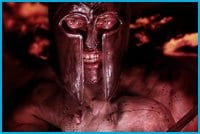There are a lot of gay men and women still in the closet. Oh, not about their sexual orientation — that’s old news. These days, many of us wannabe hipsters are far more terrified of a hot trick or posh partner lifting up the mattress one day to discover our secret stash of… comic books.
Yes, comic books. No longer simply the stuff of pimply geeks or middle-aged virgins, comics have spent the last few years clawing their way to literary legitimacy. Thanks to movies about the X-Men, Spidey and the Fantastic Four, comic publishers are enjoying a bumper crop of new and returning readers alike, while alternative presses have been flexing their muscles with more adult-themed fare.
Admirers of the spandex hero set have long flocked to conventions featuring mainstream creators from Marvel and DC Comics; the annual Comic Convention in San Diego last month boasted record attendance. For fans of adult, nonfantasy books, Mecca arises in the form of this year’s Toronto Comic Arts Festival (TCAF), Sat, Aug 18 and 19 at the University of Toronto’s Victoria College.
Sure you may not get a glimpse of your next-door neighbour poured (however unsuccessfully) into a Wonder Woman bustier, but TCAF showcases the adult graphic fiction genre that is thriving in the shadow of its flashier comic cousin.
“We started TCAF to focus on the books and the creators that are overlooked by those kind of big comics shows,” says organizer Christopher Butcher. “These people would never do a show that has guests like Adam West or one of the kids from Star Wars.”
Unlike the more mainstream conventions, TCAF’s main mandate is to promote and celebrate the diverse world of alternative comics.
“We wanted to be inclusive in the way other shows aren’t,” Butcher says. “For instance, we’ve always set a precedent to include gay cartoonists that don’t necessarily appeal to the Superman/ Batman crowd.
TCAF also illustrates that the comics industry is no longer the boys’ club it once was. “It’s getting to be that girls aren’t excluded from the industry,” says Butcher. “Like Danielle Corsetto, who just gave up her day job to work full time on her Girls with Slingshots comic strip website.”
Butcher also points to the success of Alison Bechdel (author of the Dykes to Watch Out for strip, which Xtra publishes) and her coming-of-age graphic novel Fun Home, chosen last year as Time Magazine’s book of the year.
“I really think comics are gaining in popularity and validity specifically because there are so many new voices coming in,” he says. “For the longest time there was one very dominant voice in comics: super heroes, marketed to males 18 to 40.
“The field is wide open now. We have a high density of female cartoonists and cartoonists of colour. It’s a real community.”
It was Butcher’s enthusiasm for these unsung graphic heroes that led to TCAF’s inaugural convention back in 2003 and its subsequent biannual festivities. He juggles the organizational duties with his job managing — you guessed it — a comic store. In fact, it was Butcher’s deft handling of the first TCAF that netted him a job at The Beguiling, now the festival’s primary sponsor.
The Beguiling has long been a supporter of independent comics creators over the last 20 years, holding artist events and signings in the funky Markham St store, but Butcher felt a larger venue was needed to raise the profile of the industry.
“There are a lot of cartoonists that are really great but not as well known,” he says. “You put together 40 of them and suddenly you get an event that can draw a lot of people.”
The first TCAF drew fans from all over Canada and the US, as well as some surprisingly high-profile guests. Animator John K, the man responsible for the infamous Ren and Stimpy cartoon, arrived unannounced from a production in Ottawa with his entire animation crew in tow, and treated fans to an inside look at his creative process.
This year’s lineup is equally impressive — with a healthy dose of queer. Notable homos like J Bone (The Spirit), Maurice Vellekoop (A Nut at the Opera), Joey Comeau (A Softer World; see story page 29) and Bryan Lee O’Malley (who’s straight, but his Scott Pilgrim comic has a great gay character) will be joined by gay comic luminaries Steve MacIsaac (Shirtlifters), Tim Fish (Young Bottoms in Love) and celebrated Alan Moore collaborator José Villarrubia. Some folks like Bone, Comeau, O’Malley, MacIsaac and Fish will be at booths all weekend, while others will zip in for signings in the Beguiling room at particular times (Bone at 1pm to 3pm on Saturday and 2pm to 3pm on Sunday; Vellekoop at 10am Saturday; Villarrubia at 10am Saturday and around 3pm on Sunday).
Other guests of note include Canadian graphic novelist Seth (Wimbledon Green, George Sprott), writer J Torres (Degrassi: Extra Credit, Teen Titans Go), illustrator Karl Kerschle (Superman, Teen Titans: Year One, 52) and cover artist James Jean (Fables).
***
José Villarrubia has been on a prolonged career high these past few years. The artist and photographer has succeeded in carving out a solid rep in the alternative comics world, even as he dallies with big boys Marvel and DC. Stints on Ghost Rider, Conan the Barbarian and the Eisner-winning series Batman 100 have showcased the fine artist’s unique blend of painting, photographic collage and digital colouring.
“When I first started working in the industry, it was the beginning of computer colouring,” says Villarrubia. “In the early ’90s it was very effect driven, trying to mimic the look of video games. I came from a totally different end of the spectrum. I would paint every page in watercolour, then modify in Photoshop. It’s realistic but very painterly.”
As comic colouring grew in subtlety and sophistication, so did its impact on the source material. “Colour is now really part of the storytelling. The artist is providing the actors and the sets, and the colour creates the mood and the atmosphere of the scene. I’m doing what a cinematographer would do.”
This sophisticated style of colouring brought Villarrubia to the attention of writer Alan Moore (The Watchman), who hired the artist to illustrate book seven of his Promethia graphic novel series. An illustrated book called Mirror of Love followed, with Villarrubia giving visual life to Moore’s poem of gay and lesbian history. The two are now putting the finishing touches on Moore’s version of a tarot deck.
Villarrubia will be one of the featured guests on TCAF’s Saturday panel of gay voices in comics. He’ll be joined by Fish, Bone and MacIsaac as they discuss the nature of queer contributions to the industry.
***
Steve MacIsaac’s presence in adult comics is certainly one of the most overtly out and proud. His pornalicious series Sticky, a three-part erotic collaboration with writer Dale Lazarov, has recently been collected into a hardcover edition, while his self-published Shirtlifter series takes an unabashed look at gay relationships.
The latest Shirtlifter issue, which launches at TCAF, takes a decidedly autobiographical turn. It focuses on the relationship between MacIsaac and partner Todd, and their recent struggle with US bureaucracy as Canadian émigré MacIsaac attempts to legitimize his domestic relationship with American Todd.
“It’s using our experiences and our lives in a nonfiltered way to talk about broader social issues,” says MacIsaac, who’s from Nova Scotia. “It’s just easier to use yourself as the character instead of trying to fictionalize. I’m trying to stick close to the facts as they happen, so I don’t have to worry about invention.”
The writer/artist returned fairly late to comics after a prolonged absence post-puberty. An early fascination with Peanuts and similar offerings faded with the onset of adolescence, and brief flirtations with more sophisticated comics sputtered out as dating and nightlife made greater demands on MacIsaac’s wallet.
It wasn’t until the age of 28 that a chance encounter with an adult-themed comic sparked a nostalgic interest in MacIsaac.
“I picked the comic up and remembered this sort of pleasure,” he says. “There’s a pleasurable aspect to comics that’s hard to define — the writing, the tactile quality of looking at things. It hit a sweet spot in my brain, and I became interested in that medium again.”
It helped that this more mature genre also mirrored changes in MacIsaac’s personal life at the time.
“I discovered a lot of gay comics,” he says. “I had come out as a gay man, and it became important in uncovering avenues of gay expression.”
His first comic creation emerged from this period. You Can Tell Us Anything is an ironic story of coming out to his family, contrasting images of gay lifestyle with parental censure. One particularly hilarious scene depicts a boy furtively leering at other young men in a locker room, while a text caption asks, “How come you never bring a girlfriend home?”
MacIsaac’s art since that first collection has evolved with tools learned while studying graphic design, and now embraces the digital medium once reviled by the artist.
“I admit to being a complete and utter hypocrite,” he laughs. “I hate CGI and digital art, but my already slow working process would probably screech to a halt if I did it on paper.”
This boon to product efficiency also had an unexpected effect on MacIsaac’s creative output.
“Using the computers forced me to simplify,” he says. “I’m using fairly simple blocky outlines, trying to capture and highly individuate people without the deadness that a lot of photorealistic art has.
“It’s really important for me to make people look different. If you have two bald guys in a story, you have to be able to tell one from the other. It’s like that old joke about Betty and Veronica, and how you could swap their hairstyles and not tell them apart.”


 Why you can trust Xtra
Why you can trust Xtra


